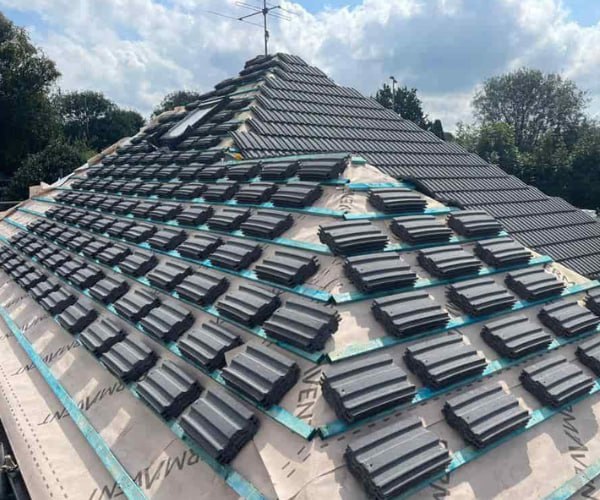How to Repair Damaged Roof Pitching After Severe Weather
Severe weather events such as heavy storms, high winds, and hail can wreak havoc on roofs, particularly affecting the pitch and overall structure. When roof pitching is damaged, it can compromise the roof’s ability to shed water effectively, leading to leaks, structural issues, and potential long-term damage. At NRS Roofing Rothwell, we specialise in repairing roofs affected by severe weather, ensuring that homes and commercial properties remain watertight and secure.
In this article, we’ll explore the steps to take when severe weather damages your roof pitching, highlighting the repair methods that can restore your roof’s stability and durability.
Assessing the Extent of Roof Pitch Damage
The first step after a severe weather event is to assess the damage. Some signs of damaged roof pitching are subtle, while others are visibly obvious. Here are some indicators to look for:
- Visible sagging or uneven pitch: Severe weather can cause structural shifting, leading to sections of the roof pitching becoming visibly uneven.
- Missing or displaced tiles: High winds and heavy rain can displace or remove tiles, leaving the pitched structure exposed to further damage.
- Water pooling or leaks: After a storm, any signs of water pooling or leaks inside the property are indications of pitching damage.
- Loose flashing and seals: Flashing around chimneys, vents, or valleys often loosens in severe weather, affecting how well the pitch directs water off the roof.
- Shingle curling or cracking: Hail or wind can damage shingles, leading to water infiltration, which affects the overall pitching’s performance.
Conducting a visual inspection is essential, but it’s best to have a professional roofing service perform a thorough examination to ensure all areas of concern are identified.
Steps to Repair Damaged Roof Pitching
- Temporary Weatherproofing
If the damage is significant, temporary weatherproofing may be needed to protect the roof from further exposure. Using tarpaulins or specialised roofing membranes can shield open sections of the roof until permanent repairs can be made. This is especially important if severe weather is expected to continue or if immediate repairs aren’t feasible. - Shingle and Tile Replacement
Missing or damaged shingles and tiles affect the roof’s integrity and its ability to shed water. Replacing these components is essential for protecting the underlying pitching structure. New tiles or shingles should match the existing ones to maintain a uniform look and performance. - Reinforcing Structural Components
Severe storms can weaken structural supports, leading to a sagging or uneven roof pitch. Reinforcing or replacing compromised rafters and beams may be required to restore the roof’s original pitch. This process ensures the roof can handle water runoff effectively and remain structurally sound. - Repairing or Replacing Flashing
Flashing is crucial to preventing water from penetrating joints and areas where the roof pitch meets other structures. Damaged or loose flashing around chimneys, vents, and dormers should be repaired or replaced to ensure a watertight seal. High-quality, weather-resistant materials are ideal for these areas to withstand future storms. - Sealing and Waterproofing
Applying a waterproof sealant or membrane over the roof’s surface provides an added layer of protection against water infiltration. For areas particularly vulnerable to water pooling or heavy rainfall, this additional barrier helps maintain the roof pitch’s effectiveness in all weather conditions. - Re-Pitching and Realignment
In cases of severe structural damage, the roof pitch may need to be adjusted or re-pitched entirely. This involves re-aligning the roof’s structure to its proper angle and ensuring all components are securely in place. Re-pitching is a specialised repair, often necessary when extreme weather has caused significant shifts or sagging. - Inspection and Final Adjustments
Once the repairs are complete, a thorough inspection ensures everything has been executed to the highest standard. Checking for alignment, weatherproofing, and structural integrity guarantees the roof pitch is restored and capable of withstanding future storms. This final step is essential to confirm that all repairs meet safety and durability standards.
Why Professional Repairs Are Essential
While minor roof repairs might be manageable for some homeowners, addressing damaged roof pitching after severe weather is complex and best left to professionals. Here’s why:
- Specialised knowledge: Roof pitching is highly technical, and improper repairs can lead to more damage and increased costs over time.
- Safety: Working on a pitched roof requires safety precautions that professionals are trained to follow.
- Long-term durability: Professional repairs ensure your roof can withstand future storms, protecting your investment.
Conclusion
Severe weather can damage your roof’s pitching, compromising its ability to protect your home or business effectively. Addressing this damage promptly with the right techniques ensures your roof remains safe, watertight, and functional. At NRS Roofing Rothwell, we provide expert services to restore your roof’s integrity after weather-related damage, using high-quality materials and skilled craftsmanship.
If your roof’s pitching has been affected by recent weather events, don’t hesitate to contact us. We’re here to provide the professional assessment, repair, and support needed to keep your property protected, no matter the weather.
Call us on: 01536 907 192
Click here to find out more about KJI Roofing Rothwell
Click here to complete our contact form and see how we can help with your roofing needs.

